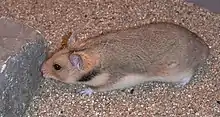Turkish hamster
The Turkish hamster, Mesocricetus brandti, also referred to as Brandt's hamster,[1][2] Azerbaijani hamster,[2] or avurtlak,[3] is a species of hamster native to Turkey,[2] Armenia and other surrounding nations.[1] The Turkish hamster, first catalogued in 1878,[1] is a fairly close relative of the Syrian or golden hamster,[2] though far less is known about it, and it is rarely kept as a pet. The population of the Turkish hamster is said to be declining in the wild,[1] yet this hamster is often used in laboratory testing.[2] Turkish hamsters have lifespans of about two years[2] and are solitary,[2][4] nocturnal animals, which practice hibernation.[1][2] They are reported to be more aggressive[2] than other members of the family Cricetidae.[2] They are tan and dark, sandy brown in color.[3] Like all hamsters, the Turkish hamster has cheek pouches that allow it to carry large amounts of food at one time.[3]
| Turkish hamster | |
|---|---|
 | |
| Scientific classification | |
| Kingdom: | Animalia |
| Phylum: | Chordata |
| Class: | Mammalia |
| Order: | Rodentia |
| Family: | Cricetidae |
| Subfamily: | Cricetinae |
| Genus: | Mesocricetus |
| Species: | M. brandti |
| Binomial name | |
| Mesocricetus brandti (Nehring, 1898) | |
Habitat and behavior
Hamsters are found in the wild throughout Europe and Asia[1][2] and are considered to be extremely adaptable,[1] living in scrublands, sand dunes, desert steppes and farmlands.[1][5] The land where the Turkish hamster lives is extremely dry and open, with fairly little vegetation aside from grasses.[1] Turkish hamsters usually live between 1,000 and 2,200 meters above sea level.[1] This hamster burrows in the ground for shelter,[1] and its burrows can be 20 inches to 6 feet below the ground surface.[1] These burrows are complex, consisting of several tunnels leading to separate cells for nesting, food, and waste.[1] Turkish hamster burrows are well-enough equipped for the hamsters to hibernate for four to 10 months (though sources do differ on this point),[1][2] sometimes sleeping for 30 days at a time,[4] though usually waking weekly for a day or two of activity.[1][2][4]
Diet
Turkish hamsters have fairly varied diets,[1] subsisting primarily on grains and herbs.[1] They do eat insects on occasion and store roots and leaves in their burrows for hibernation.[1] As Turkish hamsters often live near and among farmlands, they often eat human crops and are considered a pest.[1]
Population and endangerment
The Turkish hamster is a rare species,[1][3] but is the most widespread of the family Cricetidae. Its ability to live in a variety of environments means the Turkish hamster often lives on farmlands, and is viewed as and controlled as an agricultural pest.[1] In 1996, the Turkish hamster was categorized as an animal with the lowest risk of extinction,[1] but due to cases of direct poisoning by farmers, it is now near threatened.[1] More data are needed to understand the population decline.[1]
Reproduction
Turkish hamsters are weaned from their mothers after three weeks of nursing.[4] After eight weeks of age, females are sexually mature,[4] but males do not mature until six months of age.[4] According to iucnredlist.org, Turkish hamsters have two to four litters of young per year, with four to 20 young per litter, averaging 10.[1] Petwebsite.com differs on this point, arguing the litter size is between one and 13 young, with an average of 6.[4] The gestation lasts from 14 to 15 days,[2][4] or 16–17 days.[1] The two main breeding seasons are spring and fall,[4] when daylength is about 15–17 hours per day.[4]
Relationship to other hamsters
All hamsters are solitary creatures and are generally aggressive. Turkish hamsters are most closely related to the Syrian or golden hamster.[2] The Turkish hamster is considered to be the more aggressive of the two, but this could be because the other species has been domesticated.[3][5]
Domestic pets
Turkish hamsters are kept as a pet by some. Hamsters are aggressive by nature and these hamsters are recent pet species, yet this species is still improving. The domestication of the hamster was a fairly recent development;[5] in 1930, a family of Syrian hamsters was domesticated,[5] and this was the first instance of hamster domestication in history.[5] Since then, only five of the 18 species of hamster[5]— Campbell's dwarf hamster, the Djungarian hamster, the Roborovski hamster, the golden hamster, and the Chinese hamster—have been domesticated and are sold in pet shops.[5] Turkish hamsters are often used in laboratory experiments.[2]
References
- "Mesocricetus brandti". IUCN Red List of Threatened Species. Retrieved April 19, 2011.
- "Turkish Hamster". Hamster-Care. Archived from the original on February 13, 2012. Retrieved April 19, 2011.
- "Mesocricetus brandti - Turkish Hamster". TrekNature. Retrieved April 19, 2011.
- "Turkish Hamster". Pet Web Site. Retrieved April 19, 2011.
- "Types of Hamsters". About Breeding Knowledge. Archived from the original on December 27, 2010. Retrieved April 19, 2011.
